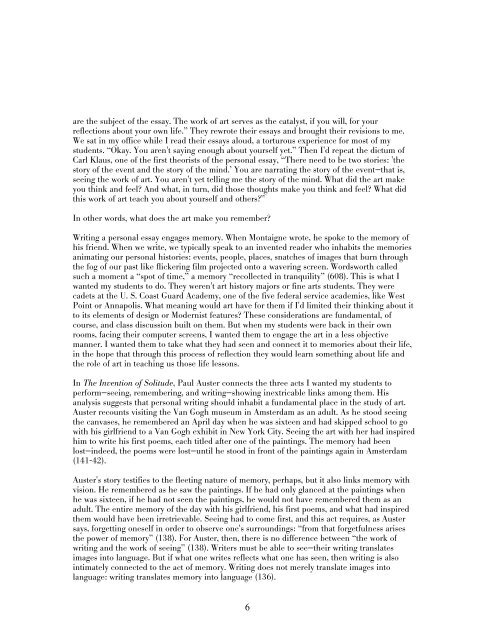SECTION 1 - via - School of Visual Arts
SECTION 1 - via - School of Visual Arts
SECTION 1 - via - School of Visual Arts
You also want an ePaper? Increase the reach of your titles
YUMPU automatically turns print PDFs into web optimized ePapers that Google loves.
are the subject <strong>of</strong> the essay. The work <strong>of</strong> art serves as the catalyst, if you will, for your<br />
reflections about your own life.” They rewrote their essays and brought their revisions to me.<br />
We sat in my <strong>of</strong>fice while I read their essays aloud, a torturous experience for most <strong>of</strong> my<br />
students. “Okay. You aren't saying enough about yourself yet.” Then I'd repeat the dictum <strong>of</strong><br />
Carl Klaus, one <strong>of</strong> the first theorists <strong>of</strong> the personal essay, “There need to be two stories: 'the<br />
story <strong>of</strong> the event and the story <strong>of</strong> the mind.’ You are narrating the story <strong>of</strong> the event—that is,<br />
seeing the work <strong>of</strong> art. You aren't yet telling me the story <strong>of</strong> the mind. What did the art make<br />
you think and feel? And what, in turn, did those thoughts make you think and feel? What did<br />
this work <strong>of</strong> art teach you about yourself and others?”<br />
In other words, what does the art make you remember?<br />
Writing a personal essay engages memory. When Montaigne wrote, he spoke to the memory <strong>of</strong><br />
his friend. When we write, we typically speak to an invented reader who inhabits the memories<br />
animating our personal histories: events, people, places, snatches <strong>of</strong> images that burn through<br />
the fog <strong>of</strong> our past like flickering film projected onto a wavering screen. Wordsworth called<br />
such a moment a “spot <strong>of</strong> time,” a memory “recollected in tranquility” (608). This is what I<br />
wanted my students to do. They weren't art history majors or fine arts students. They were<br />
cadets at the U. S. Coast Guard Academy, one <strong>of</strong> the five federal service academies, like West<br />
Point or Annapolis. What meaning would art have for them if I'd limited their thinking about it<br />
to its elements <strong>of</strong> design or Modernist features? These considerations are fundamental, <strong>of</strong><br />
course, and class discussion built on them. But when my students were back in their own<br />
rooms, facing their computer screens, I wanted them to engage the art in a less objective<br />
manner. I wanted them to take what they had seen and connect it to memories about their life,<br />
in the hope that through this process <strong>of</strong> reflection they would learn something about life and<br />
the role <strong>of</strong> art in teaching us those life lessons.<br />
In The Invention <strong>of</strong> Solitude, Paul Auster connects the three acts I wanted my students to<br />
perform—seeing, remembering, and writing—showing inextricable links among them. His<br />
analysis suggests that personal writing should inhabit a fundamental place in the study <strong>of</strong> art.<br />
Auster recounts visiting the Van Gogh museum in Amsterdam as an adult. As he stood seeing<br />
the canvases, he remembered an April day when he was sixteen and had skipped school to go<br />
with his girlfriend to a Van Gogh exhibit in New York City. Seeing the art with her had inspired<br />
him to write his first poems, each titled after one <strong>of</strong> the paintings. The memory had been<br />
lost—indeed, the poems were lost—until he stood in front <strong>of</strong> the paintings again in Amsterdam<br />
(141-42).<br />
Auster's story testifies to the fleeting nature <strong>of</strong> memory, perhaps, but it also links memory with<br />
vision. He remembered as he saw the paintings. If he had only glanced at the paintings when<br />
he was sixteen, if he had not seen the paintings, he would not have remembered them as an<br />
adult. The entire memory <strong>of</strong> the day with his girlfriend, his first poems, and what had inspired<br />
them would have been irretrievable. Seeing had to come first, and this act requires, as Auster<br />
says, forgetting oneself in order to observe one's surroundings: “from that forgetfulness arises<br />
the power <strong>of</strong> memory” (138). For Auster, then, there is no difference between “the work <strong>of</strong><br />
writing and the work <strong>of</strong> seeing” (138). Writers must be able to see—their writing translates<br />
images into language. But if what one writes reflects what one has seen, then writing is also<br />
intimately connected to the act <strong>of</strong> memory. Writing does not merely translate images into<br />
language: writing translates memory into language (136).<br />
6








